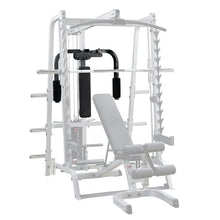Solo lifters chasing strength without a spotter, coaches running circuits with mixed experience levels, and anyone rehabbing or dialing in technique. A Smith’s guided path lets you push hard while keeping bar travel predictable and repeatable.
- Bar path: Vertical = direct feel; 7° angled = more natural squat/press groove.
- Counterbalance: Start weight can be near 0–20 lb (vs. 15–45 lb without). Great for novices and higher-rep work.
- Bearings & rails: Linear bearings glide smoother than bushings, especially under heavy loads.
- Safeties: Look for long, easy-to-set spotter stops and dense hook spacing for fine bar catches.
- Capacity & frame: Check total load rating, crossmember rigidity, and bolt-down options for commercial duty.
- Footprint & height: Plan the rack plus 24–36″ of clear working room; most units prefer 84–92″ ceilings.
- Combo features: Some pair Smith with cables or racks—handy if you’re building a single all-in-one lane.
Compare your options (decisive specs)
| Model Type | Bar Path | Counterbalanced | Guide System | Max Capacity | Safeties | Footprint Class* | Best For |
|---|---|---|---|---|---|---|---|
| Commercial Counterbalanced Smith | Vertical | Yes (≈0–20 lb start) | Linear bearings on steel rails | 800–1,000 lb | Long pop-pin spotter stops | Standard | Gyms & studios needing smooth, heavy use |
| 7° Angled Smith (Home/Light-Commercial) | 7° angled | No | Linear bearings | 600–800 lb | Multi-position steel stops | Compact | Garage gyms wanting a natural squat groove |
| Smith + Functional Trainer Combo | Vertical | Varies | Linear bearings; dual pulleys | 600–800 lb (Smith) | Adjustable safety rods + cable safeties | Standard | One-lane, do-everything setups |
| Smith + Half Rack Hybrid | 7° angled | No | Bearings or bushings (model-dependent) | 700–900 lb | Spotter arms (J-cup style) | Standard | Free-weight feel + guided backup |
| Compact Smith Tower | Vertical | No | Bushings | 500–600 lb | Short steel stops | Minimal | Small rooms, tight budgets |
| Smith + Lat/Row Attachment | 7° angled | Optional | Linear bearings + cable carriage | 600–800 lb (Smith) | Rod stops + seat/hold-down for pulldown | Standard | Strength lanes with vertical pulls built-in |
| Full-Commercial Dual-Column Smith | Vertical | Yes | Oversized linear bearings, oversized rails | 1,000+ lb | Extra-long safety travel | Large | High-traffic weight rooms & teams |
*Footprint class: Minimal (tight corners), Compact (single-car bay), Standard (typical studio lane), Large (commercial strength zone).
FAQs
Is a Smith machine good for squats and presses?
Yes—especially for hypertrophy sets, tempo work, and days when you’re training without a spotter. The fixed path helps you keep tension where you want it and makes drop sets and rest-pause easy to manage.
What’s the difference between vertical and 7° angled paths?
Vertical tracks feel more “locked-in” and are great for presses and high-incline work. A 7° path mimics the natural hip and knee drift of barbell squats, which many lifters find more comfortable for lower body.
Do I need a counterbalanced bar?
If you coach beginners, do high-rep accessories, or share the machine with different strength levels, a counterbalance is helpful—start weight can be close to zero so everyone finds a workable load.
How much weight can a Smith machine handle?
Most home/light-commercial frames are rated 500–800 lb, while full-commercial towers often exceed 1,000 lb. Always follow the manufacturer’s rating and check that anchors or feet are stable on your floor.
What accessories should I pair with a Smith?
An adjustable bench, a set of change plates for fine jumps, and if your model supports it, a lat/row or cable column for vertical pulls and face pulls. Bar pads and safety straps are optional but nice for specialty work.
Any maintenance required?
Keep guide rods clean, wipe down after sessions, and apply light manufacturer-approved lubricant to bearings/rails as needed. Check safety stops and hook engagement points regularly.
Final fit check: Measure doorways, stair turns, and ceiling height—then add 24–36″ of working space at the bar’s lowest position so safeties and benches slot in comfortably.







